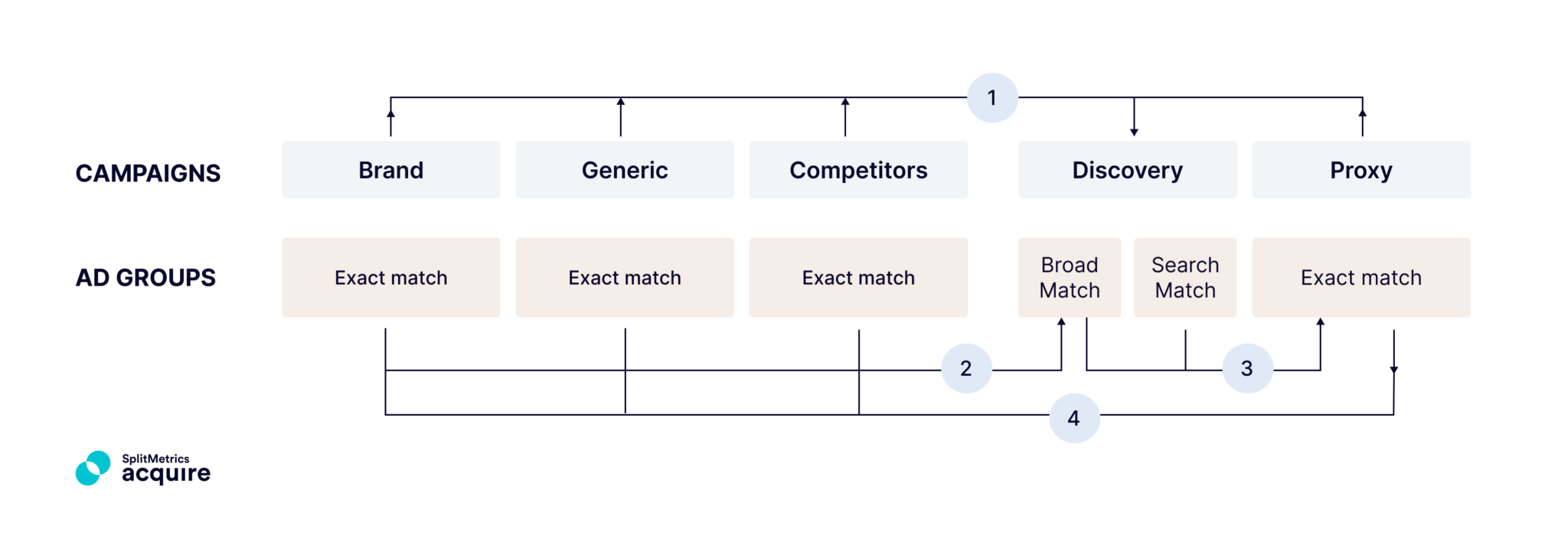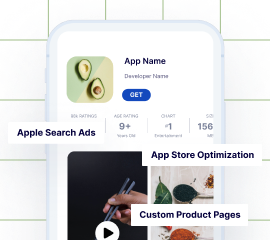Apple Ads Optimization Checklist & Troubleshooting
 Gabriel Kuriata
Gabriel Kuriata Apple Ads is a dedicated user acquisition channel for the App Store and a top priority for any app marketer promoting an iOS app or mobile game.
The advertising platform is focused, streamlined, and implementable by anyone. Still, it requires a proper understanding of the App Store environment, impacting the full scope of optimization needed to make it work and contribute to profitable app growth.
This article expands our primary introductory guide to Apple Ads by describing the full scope of its optimization and redirecting you to even more detailed guides in our educational library. The journey from a beginner to an expert in Apple Ads can be a great experience, provided you don’t skip any steps. Before reading, it would be good to have a basic understanding of key Apple Ads performance metrics and campaign structures, but you can read on them as we guide you to relevant materials along the way.
Dive deeper into Apple Ads optimization with this article. It has:
– Lots of advice on keyword research and optimization
– Practical guidance into bidding: frequency, increments, and strategies
– 12 best practices on workflow, planning, and analytics
– Tips on creating custom metrics using view-through installs
…and more!
The main areas of Apple Ads optimization are:
Keyword optimization and bid optimization are at the heart of managing Apple Ads search results ads and require regular health checks and control.
Audience, ad creative, and product page optimization are performed when needed and warranted by the app’s business model. Creative optimization is becoming increasingly important. It significantly impacts the performance of search results ads, by allowing advertisers to perfectly align app’s icon, title, subtitle and other creatives with the intent behind a specific keyword. It can help captivate more users with Today tab ads, resulting in higher tap-through and conversion rates for this placement.
App Store Optimization (ASO) is crucial for Apple Ads because its vital component is conversion rate optimization. It has a tremendous impact on attainable cost per tap (CPT), cost per acquisition (CPA), cost per goal (CPG), and return on ad spend (ROAS). ASO is focused on optimizing the default product page on an app, while custom product pages are a tool for paid user acquisition, being available for search results ads (through ad variations) and Today tab ads (being required to operate). Knowledge gained in analyzing custom product page performance can help optimize the default product page. Therefore, we treat relevant ad creatives and custom product pages as a component of Apple Ads performance optimization.
The most significant setback to success with Apple Ads is starting without a plan. There are three starting questions you should ask yourself, as only you can answer them.
You may have a single budget in mind when managing Apple Ads campaigns. Still, it’s advisable to establish separate, daily budgets for specific areas and waterfall remaining resources according to priority for transparency and future control when scaling.
The budget structure is directly reflected in your campaign structure, either semantics-based or value-based, although both models allow for a granular, budget-dependent approach in structuring.
You need to understand your app, brand, users’ journey, competitors, and functionality (which will impact the semantic core you’ll use for your campaigns). The chosen campaign structure will be critical in determining your workflow and possible automation strategy.
It’s possible to include multiple markets in a single campaign, although we’d prefer to separate them into separate ones. With multi-geo campaigns, you give up control over individual markets. There can be considerable differences between them regarding average conversion rates (CR) and cost per acquisition (CPA). It might be easier to allocate a separate budget for expansion rather than analyzing markets and selecting similar ones regarding operational costs and potential gains in a single campaign.
Seasonal and holiday campaigns are frequently tied to other promotional activities on the App Store, like in-app events or Today tab campaigns. New keywords pop up, selected ones gain more traction, and seasonal updates to product page creatives can significantly impact conversion rates and, as a result, CPA and CPG.
This is optional, but consider whether seasonality and holiday promotions are essential for your app. Separate campaigns may help you maintain transparency and improve control. However, this approach makes sense only if such activities are a vital source of new users (or increased engagement) for your mobile game or app, to an extent that warrants this more granular approach. A mobile game may find this viable when a holiday campaign is frequently coupled with a timed, meaningful, engaging in-game event.
Keyword optimization involves building and maintaining a pool of relevant keywords with high traffic potential. It’s relevant to search results ads and an integral part of creating and maintaining an Apple Ads account structure that will organize all your campaigns and ad groups.
Early keyword optimization aims to find relevant keywords with the best possible potential for high-quality traffic.
In the early stages of creating your campaigns, you’ll have no historical performance data to rely on, but both Apple Ads and the free SplitMetrics Acquire Starter Plan will help you build a strong keyword pool.
We offer a robust Keyword Discovery feature that gives you three perspectives on mining: by your app, competitors, and your choice. The platform also includes several vital metrics for keyword evaluation.
Launching your first campaigns will allow you to aggregate and process performance data for your keywords, allowing proper management within your structure and bid optimization according to their priority. How this process works depends on the principles of your campaign structure. Let’s use the process for the semantics-based campaign structure as an example:

This process is explained in great detail in our article on semantics-based structure for campaign management, so we’ll focus on the principles here:

The role of Apple Ads Discovery campaigns
An Apple Ads Discovery campaign is crucial to optimizing your keywords. It utilizes the broad match setting and the Search Match feature for the widest possible reach and continuously supplies new keywords for your other campaigns.
You need only one Discovery campaign, regardless of account structure. The logic and configuration of Discovery campaigns are well described in the article above, but given their importance, we’d like to point you to another article dedicated to their optimization:

Best keywords optimization tips
Let’s summarize this chapter by highlighting critical principles of keyword optimization:
For more insights on keyword expansion and optimization, please refer to our guide:

Bid optimization involves strategically adjusting bids to improve the performance of keywords and ads while staying within the budget. It’s relevant to all Apple Search Ads placements.
The Role of a Bid Optimization Strategy
In theory, bid optimization is straightforward and involves the following activities:
In practice, reaching profitability won’t be possible without considering an array of factors that determine our approach to bidding, with the most important ones being:
These, in turn, influence the following variables of your optimization:
The bid optimization process should be strategic and focused on your target cost per acquisition (CPA), cost per goal (CPG), or return on ad spend (ROAS), taking all the factors mentioned above into consideration.
Given the scope of the topic, it’s best if you learn more in our comprehensive guide to Apple Ads bidding.

This optimization activity applies to all Apple Ads placements: Today tab ads, Search tab ads, and product page ads. It’s highly dependent on your app’s functionality and user journey. It’s not something performed regularly. Instead, this optimization will alter your ad group structure within your campaigns. Precise targeting may be used from the first day of running Apple Ads, but this calls for careful audience segmentation.
Ad groups are containers where targeting is specified. Available options include Device type, Customer type, Gender, Age, Location, and Schedule (when your ad will be shown).
In the first quarter of 2022, 78% of App Store iOS 15 search volume came from devices with Personalized Ads turned off. Therefore, a widespread practice is to target all users within an ad group. However, can name at least several scenarios when they’re applicable:
There’s one more thing we’d like to point out:
Keywords reflect intent. Some categories (generic keywords) are more relevant than others. This can be reflected in your campaign and ad group structure, and it is well described in our article on building the semantics-based campaign structure.
Ad variations are unique creations that lead to custom product pages. They can highlight specific features or reach the maximum relevance for selected keywords. Because of these reasons, they can have significantly higher conversion rates and high download velocity.
Experimenting with custom product pages and ad creative optimization is a fun part of Apple Ads Optimization. It can tremendously impact your profitability and should be noticed by more developers.
Leverage custom product pages and ad variations to address the problem of the cost per tap (CPT) and cost per acquisition (CPA) being too high.
We can share this advice on how to optimize Apple Ads with custom product pages and ad variations to increase downloads:
For devices running iOS 18 and later, custom product pages can send users directly to a specific location inside the app, positively impacting in-app engagement. This is done utilizing deep links. For example, a custom product page showcasing a certain functionality can lead directly to the section of it inside the app, making interaction much more effortless.

Let’s discuss the most common considerations new users have when starting their campaigns in Apple Ads.
After some time, your CPT bid might have outgrown its optimal value for some keywords: it’s too high to align with the KPIs while you have already reached the optimal impression share or too high for hardly relevant keywords or those with low search popularity. You should review and reduce potentially overinflated bids.
Some keywords can be expensive because they’re popular and highly competitive. If they’re essential but financially unviable, you can try these solutions:
Try to target competitor keywords, especially those with low levels of protection, as signified by our Brand Protection insight available in the free SplitMetrics Acquire Starter Plan.
Consider running product page ads for the same reason (diverting traffic from competitors who target those strategic keywords).
Spikes in CPT are likely to indicate changes in the competitive landscape. This can be related to seasonality but doesn’t have to. The dynamic growth of a subcategory can drive high CPA, with new contenders bidding aggressively to maximize their impression share. There are two options here:
Such an occurrence isn’t unique to Apple Ads. It’s advisable to have a steady working routine or set up automation rules with alerts to turn your attention to sudden changes.
Sometimes, the overall CPA remains high even with a reasonable CPT and a good number of impressions and taps. In these cases, it makes sense to look into conversion rates to identify where drop-offs are happening in the funnel. Analyzing different stages of the funnel can pinpoint potential issues and optimize for better performance.
Again, remember that ASO is the foundation of every Apple Ads campaign!
Time for a quick summarization, or TL: DR ;). Here are some Apple Ads best practices to remember, which are crucial for healthy mobile app growth.
Monitoring view-through downloads lets you fully understand your ad’s delayed impact. You can then optimize it for immediate and delayed conversions and get a complete view of your ad performance across all placements.
You can create a custom metric in the free SplitMetrics Acquire Starter Plan to measure the effect of view-through downloads. Add a custom column in your ad manager with this formula:
(View-Through Downloads / Total Downloads) * 100.
To evaluate the effectiveness of direct interactions, create another custom metric that calculates the proportion of click-through downloads compared to total downloads:
(Click-Through Downloads / Total Downloads) * 100
If your view-through download share is higher than your tap-through download share in search results campaigns, it might mean that your ads lead to downloads without generating taps. In this case, review your Custom Product Page, as optimizing your creatives could help increase the number of taps on your ads. You can find more Apple Ads best practices in this guide:

The free SplitMetrics Acquire Starter Plan can manage Apple Ads from A to Z. Its campaign management and automation features will help you optimize Apple Ads effectively. It’s a great place to start using this channel. Give yourself a minimum of one month, preferably two months, to discover the potential of this user acquisition channel.
The free SplitMetrics Acquire Starter Plan platform will guide you through a quick, full-funnel setup. With an extensive help center and valuable tips throughout the interface, you’re sure to build a profitable app growth engine!
The SplitMetrics Starter Plan is and will be free to use (you’ll only pay for your ads), so it’s a great way to start and the most effective way to optimize Apple Ads.
